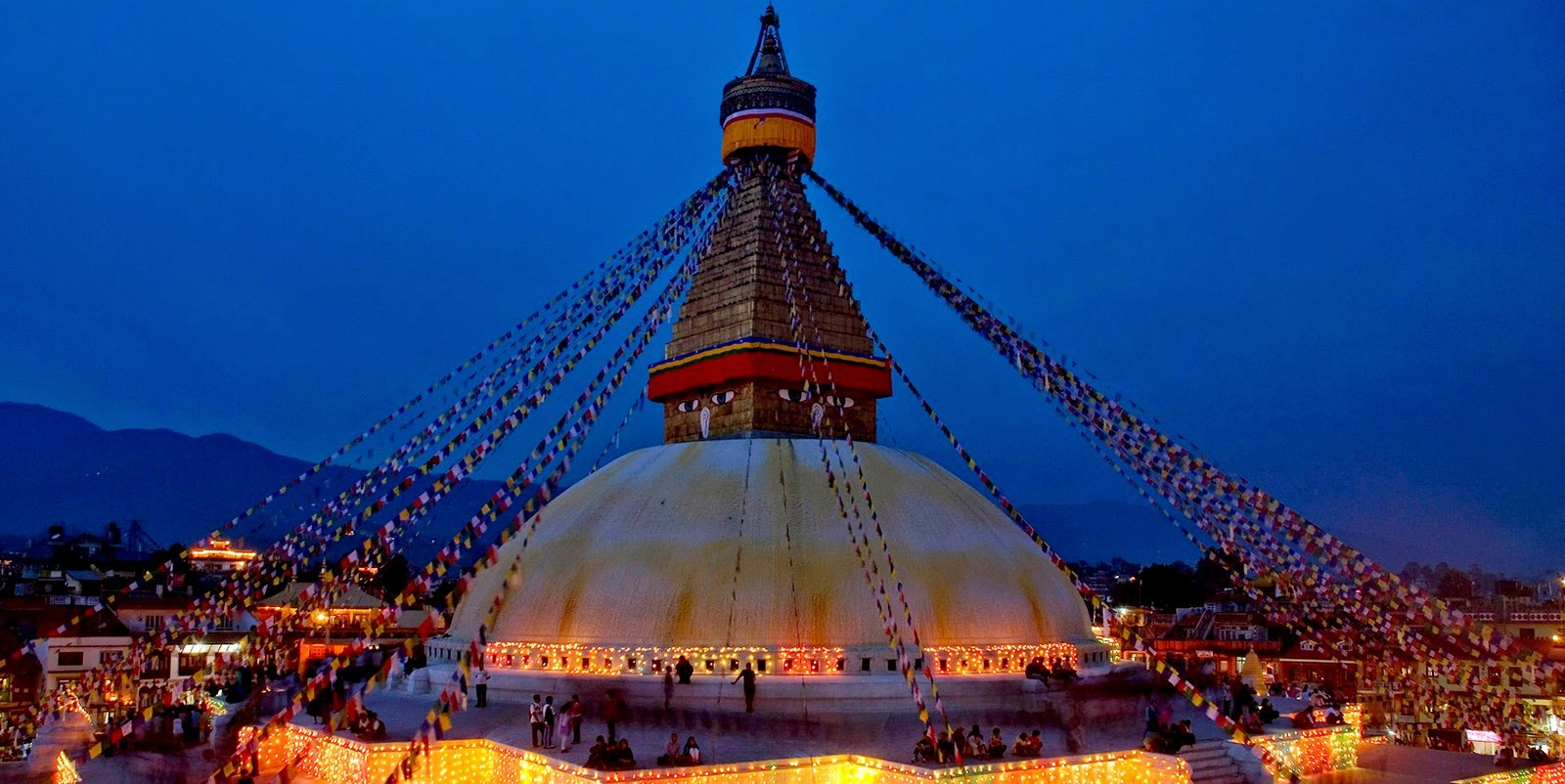Nepal UNESCO Heritage
Nepal, a country with a rich tapestry of history and culture, is home to an impressive array of UNESCO World Heritage Sites. These sites are significant for their historical and cultural value, spiritual significance, and architectural brilliance. Here are some key aspects of Nepal's UNESCO heritage:
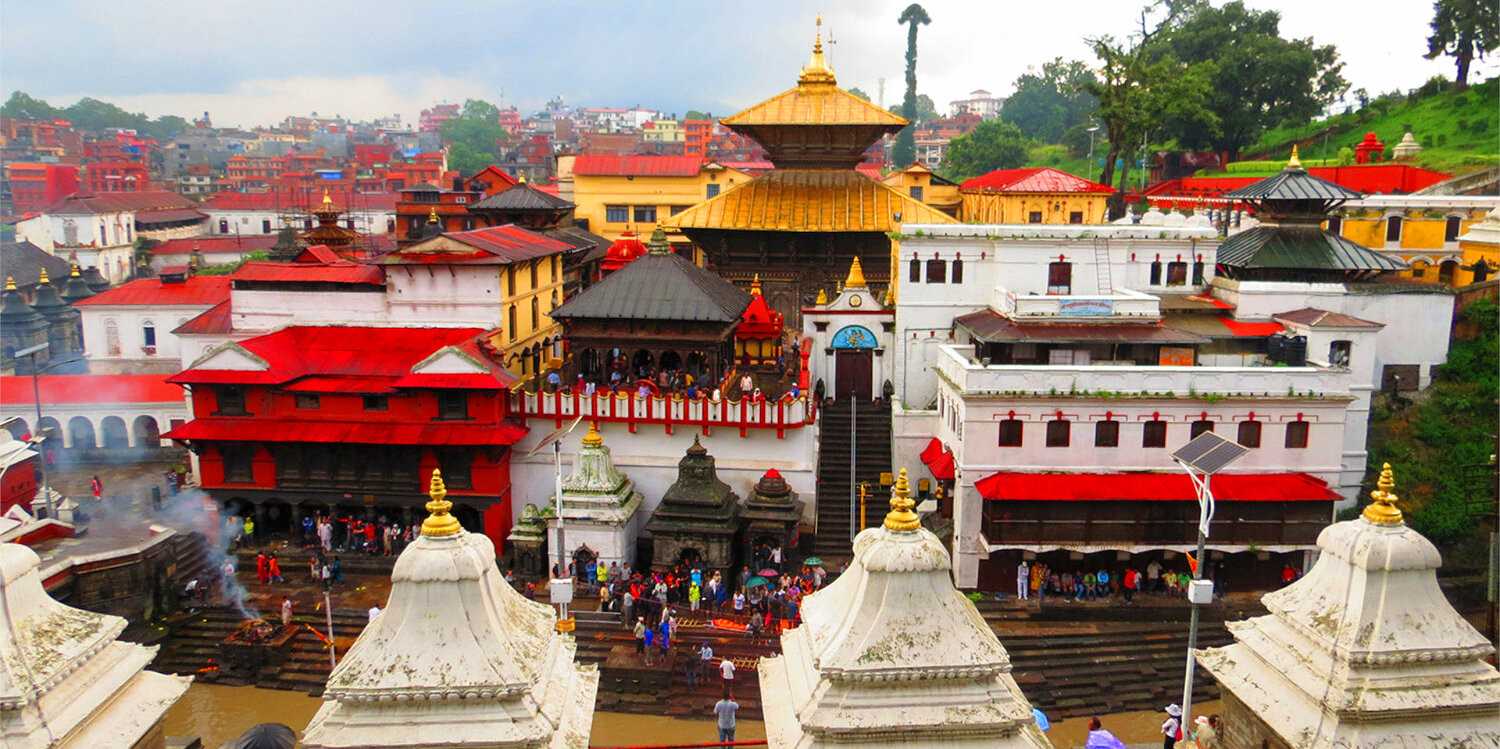
-
Kathmandu Valley: The Kathmandu Valley alone houses seven UNESCO World Heritage Sites. These include the Durbar Squares of Kathmandu, Patan, and Bhaktapur, which are famous for their exquisite temple architecture and palatial buildings. Each square reflects the rich art, culture, and history of the Malla dynasty.
-
Swayambhunath Stupa: Also known as the Monkey Temple, Swayambhunath is an ancient religious complex atop a hill in the Kathmandu Valley. It's one of the most important Buddhist sites in Nepal and offers a panoramic view of the city.
-
Pashupatinath Temple: This sacred Hindu temple is located on the banks of the Bagmati River. Dedicated to Lord Shiva, Pashupatinath is renowned for its magnificent architecture and is a significant destination for Hindu pilgrims.
-
Boudhanath Stupa: One of the largest stupas in the world, Boudhanath is a prominent centre of Tibetan Buddhism in Nepal. The stupa is known for its massive mandala and the all-seeing eyes of Buddha on all four sides.
-
Changu Narayan Temple: This temple, located near Bhaktapur, is dedicated to Lord Vishnu. It is considered the oldest temple in Nepal, showcasing ancient art and architecture.
These sites collectively offer a glimpse into Nepal's diverse cultural landscape, reflecting a history that spans millennia. Visitors to these sites can expect to be transported back in time, experiencing the ancient rituals, architectural marvels, and spiritual ambiance that are an intrinsic part of Nepal's heritage. For those looking to explore beyond the surface, Nepal's UNESCO Heritage Sites provide an in-depth look into the country’s rich and varied past.
Lumbini Pilgrimage
Lumbini, situated in the Terai plains of Nepal, is not just a UNESCO World Heritage Site but a place of profound spiritual significance. It is revered as the birthplace of Siddhartha Gautama, the Lord Buddha, and attracts thousands of pilgrims and visitors each year. A pilgrimage to Lumbini offers a deep dive into the origins of Buddhism and an opportunity to experience the tranquilly and spirituality of this sacred site.
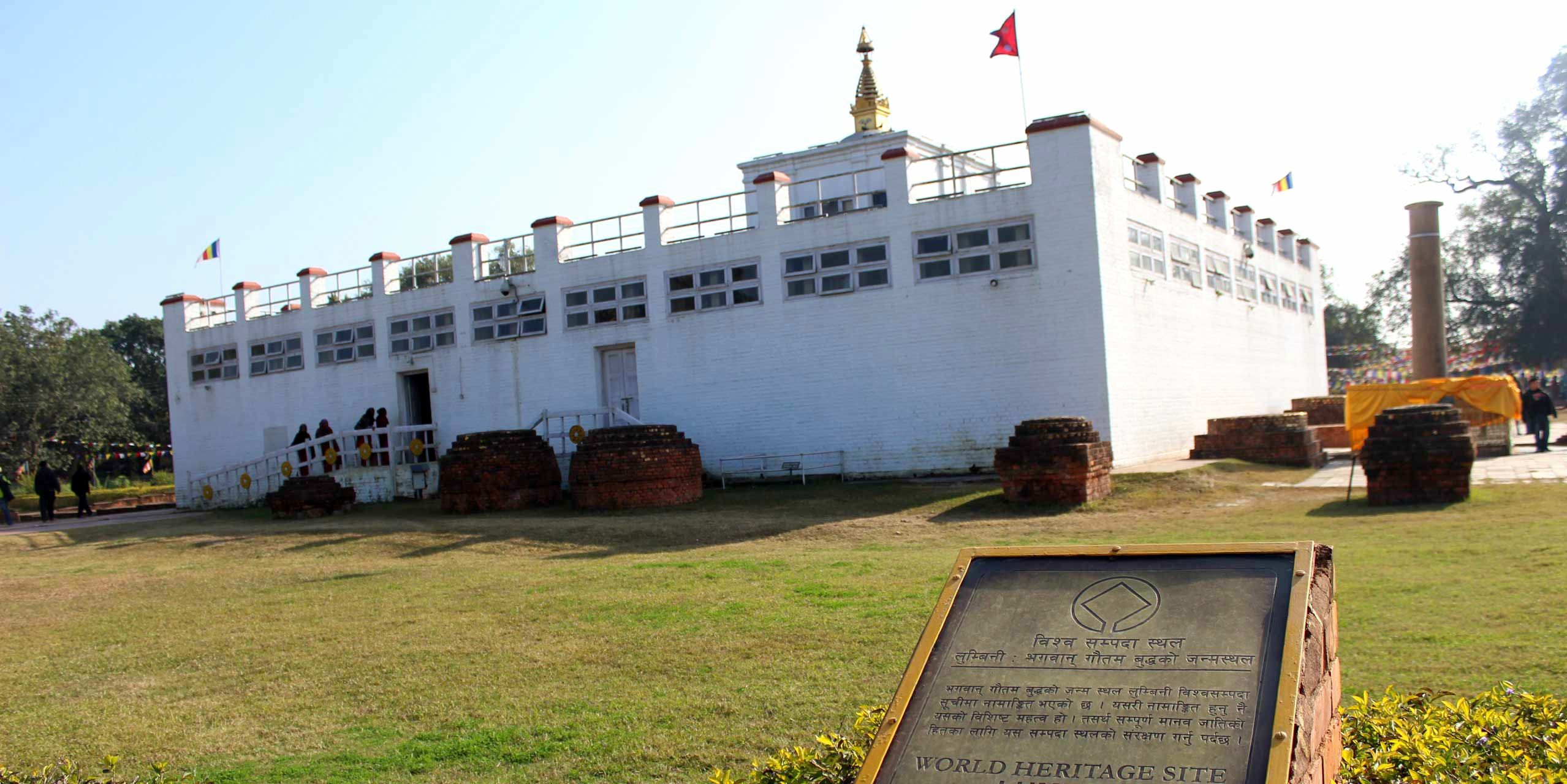
Key Highlights of Lumbini
-
Mayadevi Temple: The heart of Lumbini is the Mayadevi Temple, named after Buddha's mother. It marks the precise spot where Buddha was born. The temple houses an ancient stone relief depicting the birth scene of Buddha and is surrounded by the remains of ancient monasteries.
-
Sacred Garden and the Ashoka Pillar: Surrounding the temple is a peaceful Sacred Garden, filled with lush greenery and a serene pond. The Ashoka Pillar, erected by Emperor Ashoka in the 3rd century BC, stands as a testament to Lumbini’s historical significance. The pillar bears an inscription confirming Lumbini as Buddha’s birthplace.
-
Monastic Zone: Lumbini's monastic zone, divided into the East and West monastic zones, houses monasteries built by Buddhist communities from around the world. Each monastery reflects the architectural style of its respective country, providing a unique and global perspective on Buddhist traditions.
-
Lumbini International Research Institute: For those interested in Buddhist teachings and history, the institute offers a wealth of resources, including a large collection of books and manuscripts on religion, philosophy, art, and architecture.
-
The Eternal Peace Flame: A symbol of peace and harmony, the Eternal Peace Flame burns continuously and is a focal point for meditation and reflection for visitors.
-
Meditation and Retreat Centres: Numerous meditation and retreat centres around Lumbini offer visitors a chance to engage in spiritual practices, meditation sessions, and mindfulness workshops in a serene and contemplative environment.
-
Cultural Celebrations: Various Buddhist festivals and cultural events are celebrated in Lumbini, especially during Buddha Jayanti (Buddha’s birthday), offering a chance to witness traditional rituals and ceremonies.
A pilgrimage to Lumbini is more than just a visit to a historical site; it's a journey into spiritual awakening and peace. It offers a unique opportunity to walk in the footsteps of one of the greatest spiritual leaders, providing insights not only into Buddha's life but also into the principles of Buddhism. Whether you are a spiritual seeker, a history enthusiast, or simply in search of peace, Lumbini is a destination that resonates with profound tranquilly and historical significance.
Pokhara Culture
Pokhara, often known as the gateway to the Annapurna Circuit, is much more than a starting point for trekkers and adventurers. This enchanting city, nestled against the backdrop of the majestic Himalayas and the serene Phewa Lake, is a melting pot of diverse cultures and traditions. The rich tapestry of Pokhara culture is a blend of natural beauty and cultural heritage, making it a must-visit for anyone seeking to experience the multifaceted cultural landscape of Nepal.
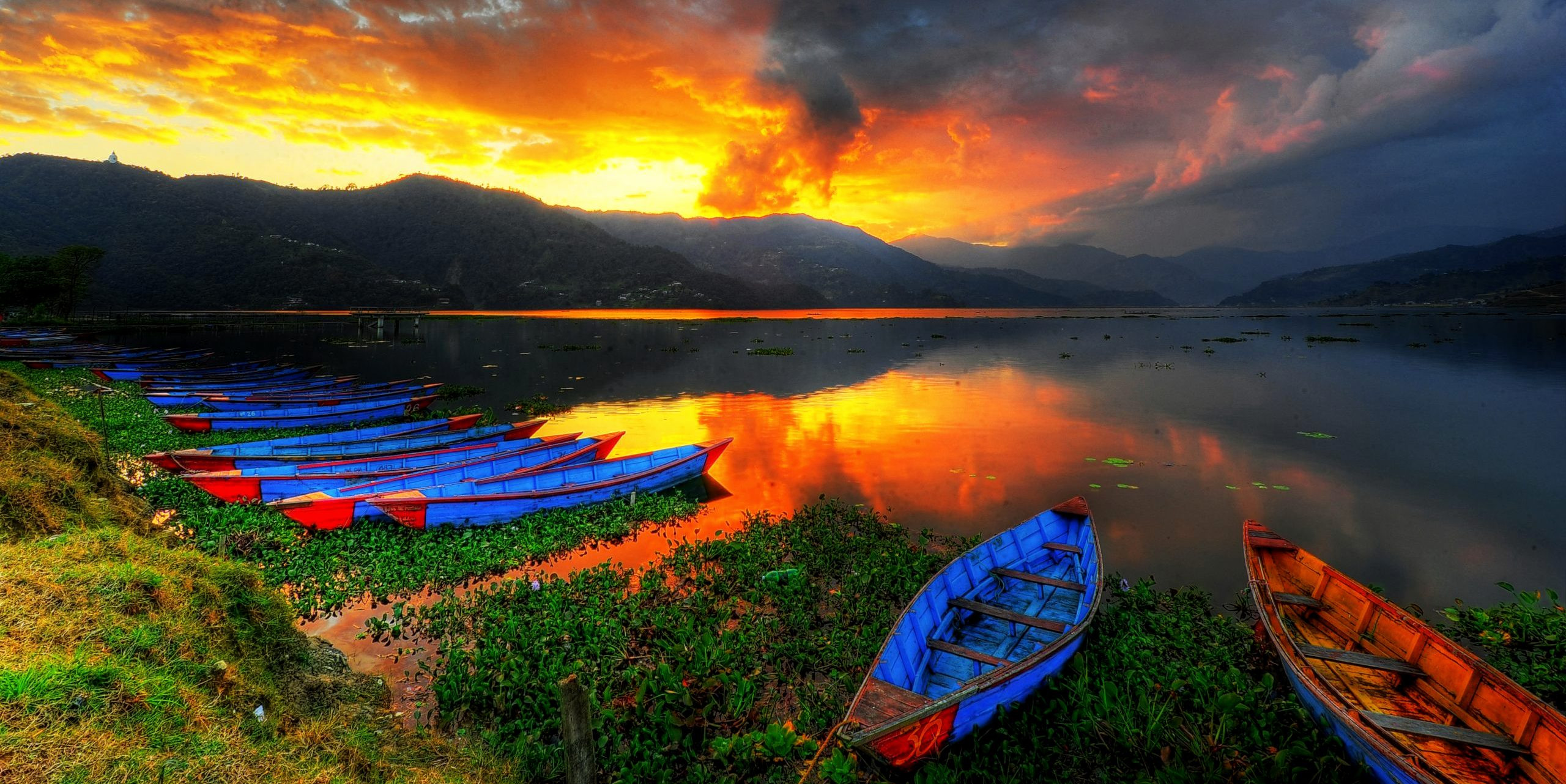
Key Aspects of Pokhara's Culture
-
Religious Harmony: Pokhara is a testament to Nepal's religious harmony, hosting both Hindu temples and Buddhist monasteries. The Tal Barahi Temple, located on an island in the middle of Phewa Lake, is a significant Hindu shrine, while the World Peace Pagoda, perched atop a hill, is a symbol of peace and a vantage point for breathtaking views of the city and the Annapurna range.
-
Cultural Festivals: The city comes alive during various festivals, with the most notable being Dashain, Tihar, and Teej. These festivals are celebrated with great enthusiasm, showcasing traditional music, dance, and rituals that reflect the rich cultural fabric of the region.
-
Music and Dance: Traditional Nepali music and dance are integral parts of Pokhara's culture. The city hosts various cultural performances, including traditional Gurung dances and music events that showcase ethnic heritage and folklore.
-
Art and Craftsmanship: Pokhara is known for its vibrant arts scene. Local handicrafts, such as hand-woven textiles and intricately designed pottery, are not only souvenirs but also representations of the city's artistic heritage.
-
Cuisine: The food in Pokhara is as diverse as its culture, featuring a mix of traditional Nepali, Tibetan, and international cuisines. Visitors can enjoy traditional dishes like Dal Bhat, Momos, and Thukpa, as well as freshly caught fish from Phewa Lake.
-
Museums and Galleries: The city is home to several museums, like the International Mountain Museum, which provides insights into the lives of mountain climbers, the history of mountaineering, and the ethnic groups of the Himalayas.
-
Ethnic Diversity: The population of Pokhara is a blend of various ethnic groups, including the Gurungs, Magars, and Newars, each contributing to the city’s cultural richness. This diversity is evident in the daily life, festivals, and traditions of the city.
-
Literature and Poetry: Pokhara also has a thriving literary scene, with many local poets and writers contributing to Nepali literature, often inspired by the city's natural beauty and cultural depth.
-
Lifestyle: The lifestyle in Pokhara is a unique mix of traditional values and modern influences, reflected in the day-to-day activities, clothing, and interactions of its people.
-
Adventure and Culture Interplay: While adventure sports like paragliding, trekking, and boating are popular, they often intertwine with cultural experiences, offering visitors a holistic experience of Pokhara’s natural beauty and cultural heritage.
Pokhara’s culture is a vibrant mosaic, rich in traditions and modern influences, set in one of the most picturesque locations in Nepal. It offers a unique and enriching experience to its visitors, combining the tranquilly of its natural landscapes with the vibrancy of its cultural heritage.
Chitwan Tharu Community
Nestled in the lowlands of the Terai region, Chitwan is not just famous for its National Park but also for the rich cultural heritage of the Tharu community. The Chitwan Tharu community is an ethnic group indigenous to the Terai region, known for their unique culture, traditions, and close relationship with the natural environment. Exploring the Tharu culture offers a fascinating glimpse into a lifestyle that is harmoniously integrated with nature and tradition.
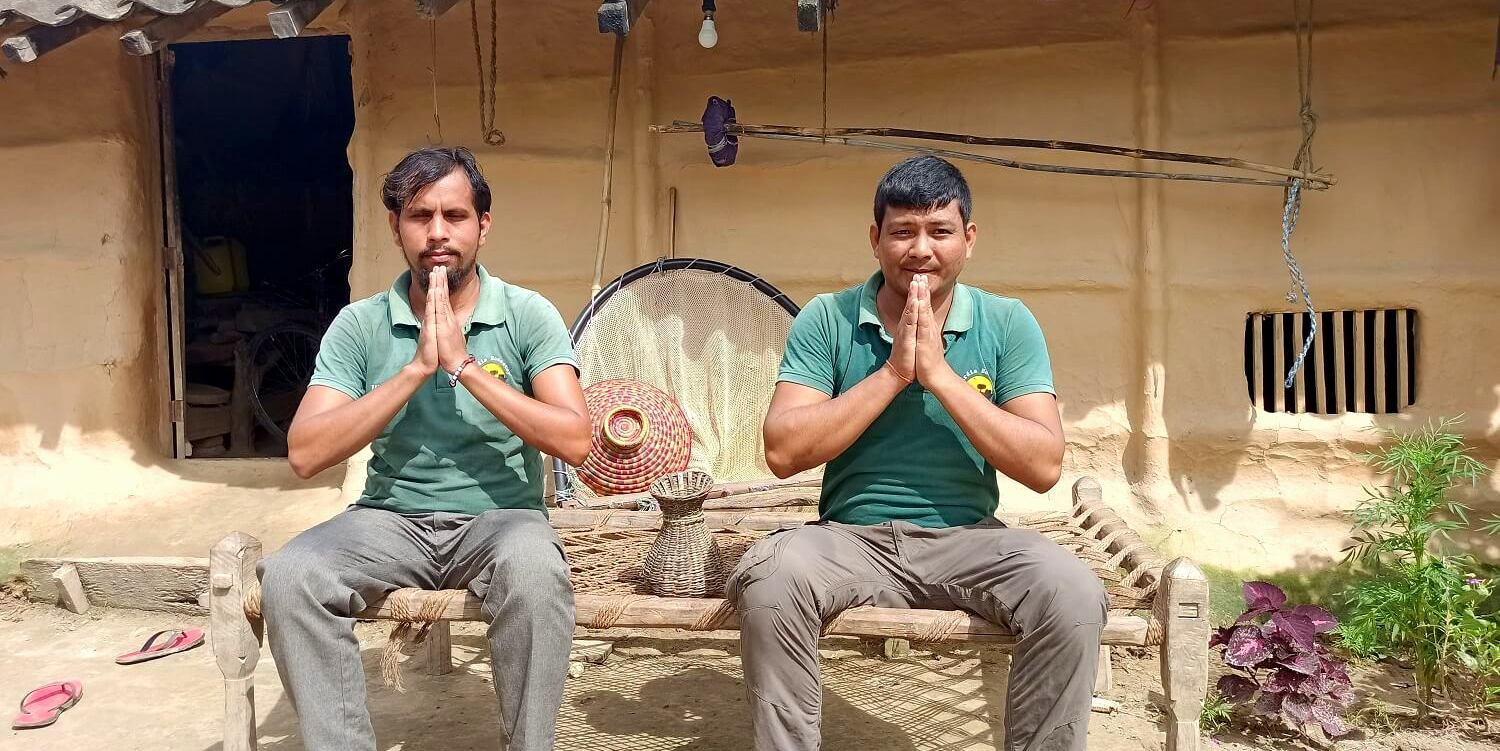
Key Elements of the Tharu Culture in Chitwan
-
Traditional Villages: The Tharu villages in Chitwan are characterised by their mud houses with thatched roofs, decorated with intricate wall paintings using natural dyes. These villages offer an authentic insight into the Tharu way of life.
-
Cultural Dance and Music: The Tharu people have a rich tradition of dance and music, which is an integral part of their cultural celebrations. The Stick Dance, known as ‘Sakhiya’, is particularly famous and is performed during festivals and community gatherings.
-
Unique Cuisine: The Tharu cuisine is distinct, with a reliance on local ingredients like fresh fish from the rivers, homegrown vegetables, and rice. Their traditional dishes reflect their resourcefulness and connection with the land.
-
Agricultural Practices: The Tharu community has been practicing sustainable agriculture for centuries. Their farming techniques are well-adapted to the local environment, showcasing an impressive knowledge of the land and its resources.
-
Traditional Attire: Tharu men and women wear traditional dresses that are colourful and adorned with unique jewellery. The women's attire, in particular, is noted for its vibrant colours and patterns.
-
Language and Literature: The Tharu people have their language and a rich oral tradition of folklore, stories, and legends, which are often passed down through generations.
-
Festivals and Rituals: The Tharu community celebrates various festivals unique to their culture, with rituals and ceremonies that are deeply rooted in their beliefs and history.
-
Eco-friendly Lifestyle: Living in close proximity to the Chitwan National Park, the Tharus have developed a lifestyle that is environmentally conscious and sustainable, making them early practitioners of eco-friendly living.
-
Handicrafts: Tharu handicrafts, such as baskets woven from natural fibres, are not only functional but also hold cultural significance. These handicrafts are a testament to their skill and creativity.
-
Interaction with Nature: The Tharus have a deep understanding and respect for their natural surroundings. This connection is evident in their traditional practices, beliefs, and sustainable ways in which they interact with the environment.
The Chitwan Tharu community offers a rich cultural experience, distinctly different from the high-altitude Himalayan cultures of Nepal. Visitors have the opportunity to learn about and appreciate a way of life that has been shaped by the unique environment of the Terai region. Exploring the Tharu culture is not just about observing their customs and traditions, but also understanding their profound connection with nature and their role in preserving the delicate ecosystem of the Chitwan area.
Nepali Festivals
Nepal, a country of diverse cultures and traditions, celebrates a myriad of festivals throughout the year. These festivals, or 'Parvas', are not just significant religiously but are also deeply rooted in the socio-cultural fabric of the country. The Nepali festivals are vibrant, colourful, and filled with a sense of community, reflecting the rich heritage and traditions of the Nepalese people.
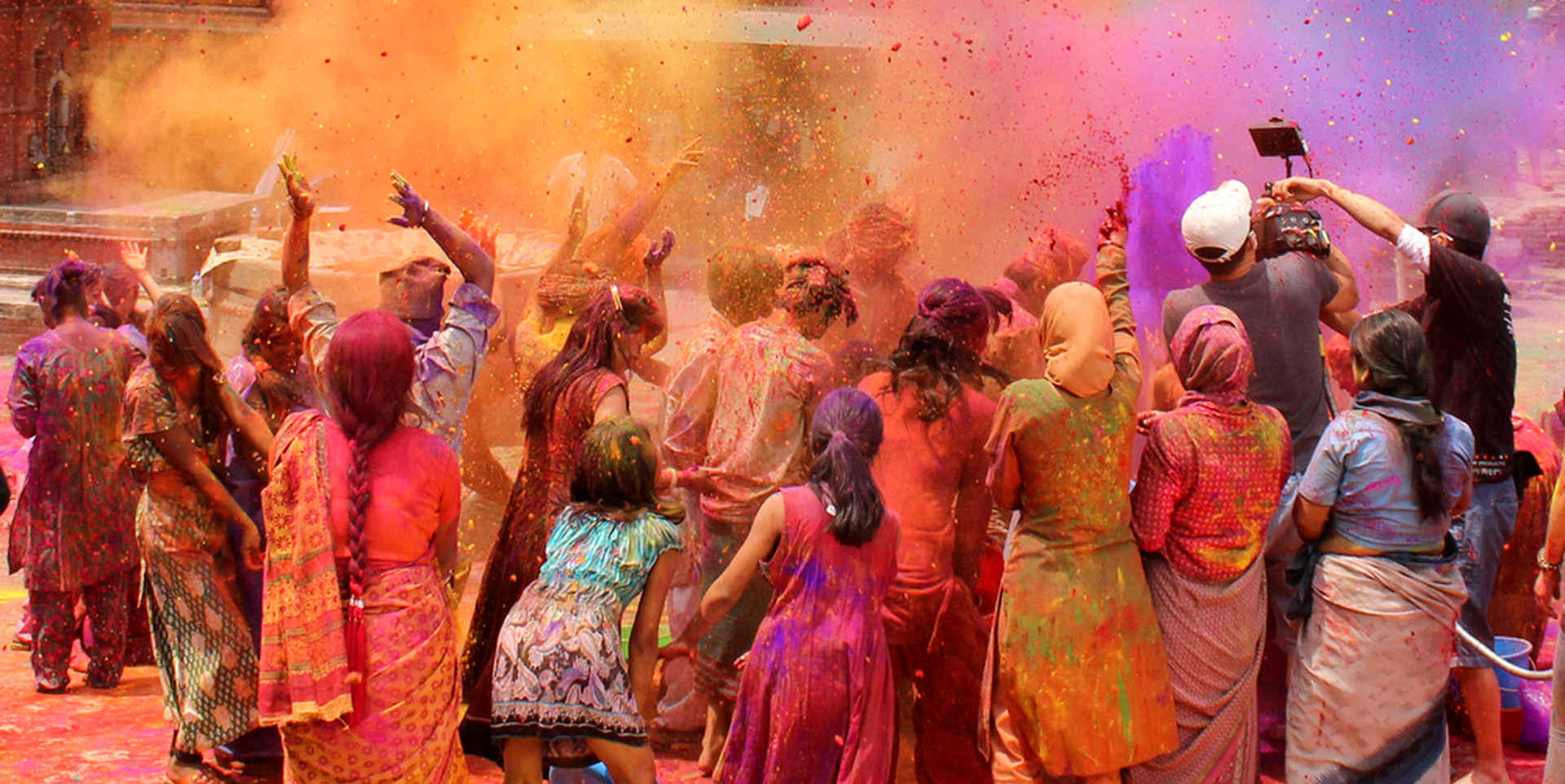
Major Nepali Festivals
-
Dashain: Dashain is the longest and the most auspicious festival in the Nepalese annual calendar, celebrated by Nepalese of all castes and creeds throughout the country. It symbolizes the victory of good over evil and is marked by family gatherings, special pujas, and offerings. Elders give 'Tika' and 'Jamara' along with blessings to younger family members.
-
Tihar (Deepawali): Known as the Festival of Lights, Tihar is the second biggest festival after Dashain. It is a five-day festival that honors different animals such as crows, dogs, and cows, as well as Laxmi, the Goddess of Wealth. Homes and streets are decorated with lights, and there is a tradition of playing Deusi-Bhailo, a form of singing and dancing.
-
Holi: The festival of colours, Holi, is celebrated with great enthusiasm in Nepal. It marks the arrival of spring and is characterized by the throwing of colored powders and water, symbolizing the vibrant life and energy of the spring season.
-
Teej: Teej is a significant festival for Hindu women. It involves fasting by women for the longevity and prosperity of their husbands and families. The festival is marked by singing, dancing, and gatherings of women in temples.
-
Indra Jatra: This is an eight-day festival celebrated in Kathmandu, marked by processions and masked dances. The Living Goddess Kumari is paraded through the city in a chariot, and the festival is also famous for the Lakhey dance, depicting a demon of the same name.
-
Buddha Jayanti: Buddha Jayanti celebrates the birth, enlightenment, and death of Gautam Buddha. It is observed by visiting Buddhist monasteries, lighting butter lamps, and engaging in prayer.
-
Janai Purnima: Also known as Rakshya Bandhan, this festival involves the changing of the sacred thread (Janai) by Brahmins and Chhetris. It also includes a special soup called 'Kwati', made of sprouted beans.
-
Gai Jatra: The festival of cows, Gai Jatra, is celebrated in Kathmandu valley to commemorate the deceased from the past year. It features processions, costumes, and satirical performances in the streets.
-
Maha Shivaratri: Maha Shivaratri is dedicated to Lord Shiva and is marked by fasting and night-long vigils at Shiva temples. Pashupatinath Temple in Kathmandu sees thousands of devotees and sadhus (holy men) during this festival.
-
Maghe Sankranti: This festival marks the end of the winter solstice and involves feasting on yams, sweets, and a special dish called 'Khichdi'.
The Nepali festivals are a spectacular display of cultural richness and communal harmony, each with its own unique customs and traditions. They provide an excellent opportunity for visitors to experience the vibrant culture and religious diversity of Nepal. Whether it's the colorful celebrations of Holi, the familial bonds during Dashain, or the spiritual observances of Maha Shivaratri, these festivals offer a glimpse into the heart and soul of Nepal's cultural identity.
Newari Arts and Crafts
The Newar community, indigenous to the Kathmandu Valley in Nepal, is renowned for its rich cultural heritage, which is vividly reflected in their arts and crafts. Newari arts and crafts are not just expressions of creativity but are deeply embedded in the community's history, rituals, and daily life, often symbolizing their religious beliefs and social values.
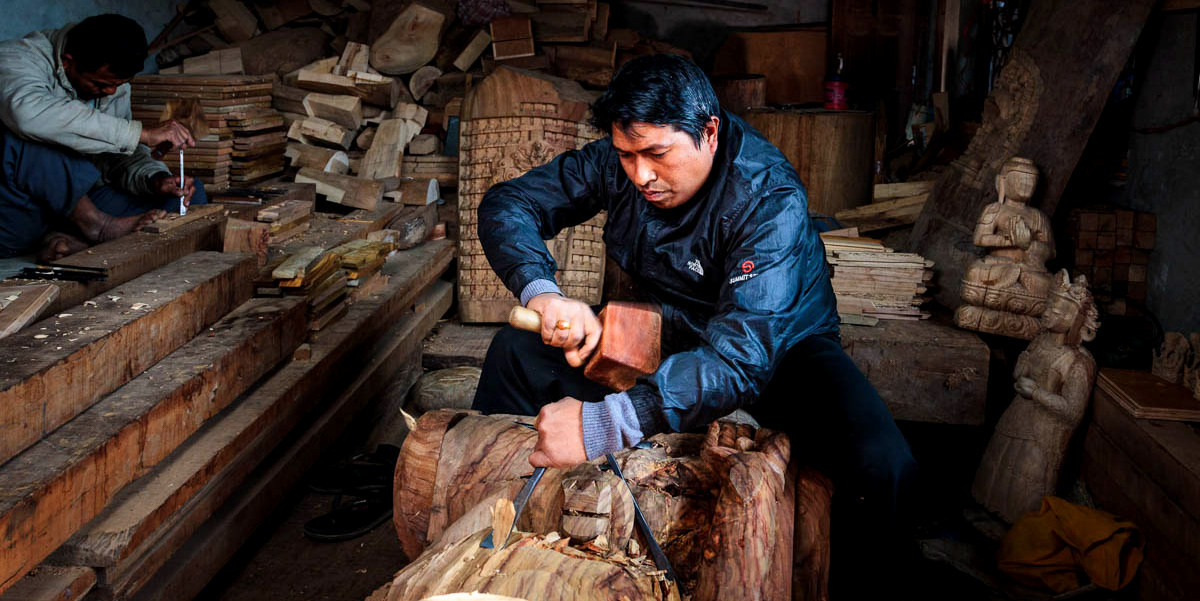
Key Aspects of Newari Arts and Crafts
-
Wood Carving: Newari wood carving is famous for its intricacy and fine detail, often depicting gods, goddesses, and mythical creatures. The peacock window in Bhaktapur is a prime example of this craftsmanship. These carvings are commonly seen in temples, palaces, and traditional Newari homes.
-
Metalwork: The Newars are skilled in metal craftsmanship, creating exquisite statues and ritual objects predominantly in copper, bronze, and silver. The art is most visible in the idols and palatial décor found in the valley's numerous temples and stupas.
-
Paubha or Thangka Paintings: Paubha (Newari) or Thangka (Tibetan) paintings are intricate and colorful depictions of Buddhist and Hindu deities and mandalas. These paintings serve both as objects of worship and meditation aids.
-
Pottery: The ancient city of Bhaktapur, also known as the city of potters, is famous for its pottery. The Newars use traditional techniques to create pots, vases, and ceremonial items from local clay, often seen drying in the sun around Bhaktapur's Pottery Square.
-
Stone Carving: Newari stone carving is another traditional craft, evident in the numerous temples and stupas throughout Kathmandu. These carvings often depict religious and cultural stories and are known for their durability and intricate detailing.
-
Jewelry Making: Newari jewelry, known for its intricacy and craftsmanship, is an integral part of the community’s attire, especially during festivals and rituals. These pieces often carry symbolic meanings and are crafted with precision.
-
Textile Weaving: Traditional Newari textiles, such as Dhaka fabric, are renowned for their intricate patterns and are used to make clothes and accessories. The Dhaka topi, a traditional Nepalese hat, is a popular item made from this fabric.
-
Mask Making: Masks representing various deities and spirits play a significant role in Newari festivals and rituals. These masks, crafted from wood or papier-mâché, are used in dances and processions.
-
Culinary Arts: Newari cuisine is also an art form, known for its variety and flavor, integral to Newari culture. Dishes like Yomari, Bara, and various types of Momo are not only delicious but also have cultural significance.
-
Architecture: Traditional Newari architecture, seen in the old towns of Kathmandu, Patan, and Bhaktapur, is characterized by intricately carved wooden windows and doors, beautifully crafted courtyards, and tiered temples.
Newari arts and crafts are a window into the soul of Newar culture, reflecting their deep-rooted traditions, religious beliefs, and social practices. Each craft tells a story, whether it's a wood carving depicting a religious tale or a Thangka painting illustrating the cosmos. For visitors to Nepal, experiencing these arts and crafts is not just about admiring the aesthetic beauty but also understanding the rich cultural tapestry of the Newar community.
Nepal Spiritual Retreats
In the serene landscapes of Nepal, nestled amidst the majestic Himalayas and verdant valleys, spiritual retreats offer a haven for those seeking peace, introspection, and a deeper connection with their inner selves. Nepal spiritual retreats are not just about physical relaxation but also about mental and spiritual rejuvenation, drawing from the country’s rich spiritual traditions and natural beauty.
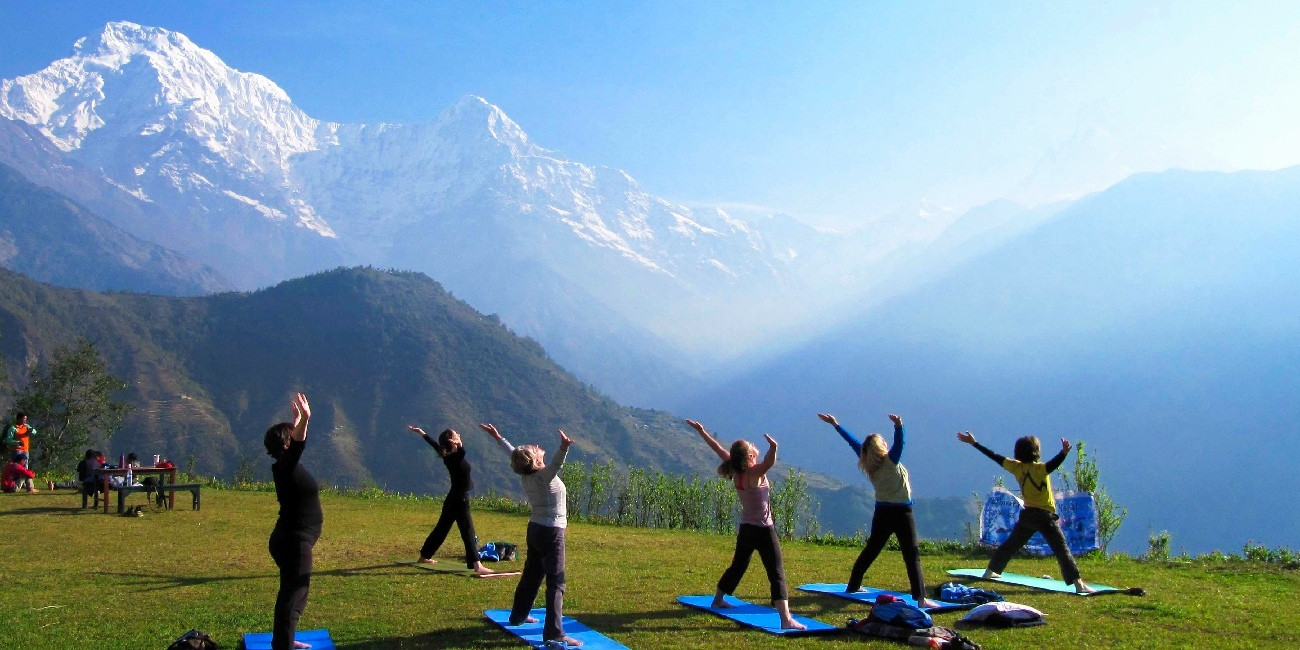
Key Features of Nepal's Spiritual Retreats
-
Yoga and Meditation: Many retreats in Nepal focus on yoga and meditation, drawing from ancient practices deeply rooted in the region's spiritual history. These retreats cater to all levels, from beginners to advanced practitioners, and often combine physical postures (asanas), breathing techniques (pranayama), and meditation (dhyana).
-
Buddhist Retreats: With Buddhism being a significant part of Nepalese culture, several retreats offer an immersive Buddhist experience. These include teachings on Buddhist philosophy, guided meditation sessions, and the opportunity to participate in traditional Buddhist rituals.
-
Hindu Spiritual Practices: Hinduism, another major religion in Nepal, also influences the spiritual retreat landscape. These retreats might involve Hindu rituals (pujas), mantra chanting, and teachings from Hindu scriptures.
-
Natural Settings: The retreats are often located in tranquil settings — from the foothills of the Himalayas to the lush Kathmandu Valley — offering stunning natural backdrops that promote peace and contemplation.
-
Wellness and Healing: Aside from spiritual practices, these retreats often incorporate holistic wellness and healing approaches, including Ayurvedic treatments, naturopathy, and wellness counseling.
-
Cultural Integration: Many retreats provide an opportunity to learn about and immerse oneself in Nepalese culture, including local cuisine, traditional crafts, and village tours.
-
Personal Growth Workshops: Workshops focusing on personal development, stress management, and life coaching are common, helping individuals to achieve a sense of balance and purpose.
-
Eco-friendly Practices: Emphasizing sustainability, many spiritual retreats in Nepal are eco-friendly, using renewable energy sources, organic farming, and eco-construction methods.
-
Customized Retreats: Catering to diverse needs, several retreats offer personalized experiences, including silent retreats, detox programs, and spiritual counseling.
-
Community Involvement: Some retreats encourage participation in community service, providing a unique way to connect spiritually while contributing positively to the local community.
Nepal spiritual retreats offer a profound journey into self-discovery and spiritual awakening, set against the backdrop of one of the most spiritually rich and naturally beautiful countries in the world. Whether you seek to deepen your meditation practice, learn about Eastern spiritual traditions, or simply find peace away from the hustle of modern life, Nepal's retreats provide a nurturing and enlightening environment.
Cooking classes
As part of our Cultural Gems of Nepal tour, Relax Getaways offers an exceptional cooking class experience, a perfect blend for those eager to delve into the culinary side of Nepal's rich culture. This cooking class is more than just a learning experience; it's an immersion into the heart of Nepalese tradition and lifestyle.

Cooking Class Highlights
-
Traditional Nepalese Cuisine: Learn how to prepare authentic Nepalese dishes under the guidance of local chefs. The class includes popular dishes like Dal Bhat (lentil soup and rice), Momos (Nepalese dumplings), and other traditional fares.
-
Local Ingredients and Techniques: Discover the use of local ingredients, spices, and unique cooking techniques that define Nepalese cuisine. Understand the significance of each ingredient and its role in Nepalese culture.
-
Hands-on Experience: Engage in a hands-on cooking experience, where you not only observe but actively participate in the cooking process, from preparation to cooking and finally, tasting.
-
Cultural Insight: While cooking, learn about the culinary traditions of Nepal, the influence of various ethnic groups on the cuisine, and the role of food in Nepalese festivals and daily life.
-
Interactive Sessions: The classes are interactive, providing an opportunity to ask questions, share experiences, and even exchange recipes with local chefs and fellow participants.
-
Market Visits: Some classes include a visit to a local market, offering insights into the daily life of Nepalese people and the chance to select fresh ingredients for your cooking session.
-
Enjoy Your Creations: At the end of the class, sit down and enjoy the delicious meal you've prepared, often accompanied by traditional Nepalese beverages.
-
Take Home Recipes: Leave the class not just with full bellies but also with recipes that you can take back home, allowing you to recreate the flavors of Nepal in your kitchen.
Our cooking class is an integral part of the Cultural Gems of Nepal tour, offering a unique and tasty way to connect with Nepalese culture. It’s an experience that caters to culinary enthusiasts and cultural explorers alike, adding an extra flavor to your journey with Relax Getaways. Join us to stir, sizzle, and savor the true essence of Nepal.
Health and Safety during Cultural Gems of Nepal: Exploring Beyond the Trekking Trails
Exploring the Cultural Gems of Nepal: Exploring Beyond the Trekking Trails is an enriching experience that brings you closer to the country's rich heritage and traditions. However, ensuring health and safety during this journey is paramount. Here are some key considerations for a safe and healthy trip:
-
Vaccinations and Health Precautions: Before traveling, it's crucial to be up-to-date with routine vaccinations. Depending on your itinerary, vaccinations for Hepatitis A, Typhoid, and Japanese Encephalitis may be recommended. Consult your healthcare provider for personalized advice.
-
Altitude Sickness: While exploring cultural sites, especially in higher altitudes like Kathmandu or mountainous regions, be mindful of altitude sickness. Acclimatize gradually and stay hydrated.
-
Travel Insurance: Ensure you have comprehensive travel insurance that covers medical emergencies, including evacuation if needed. This is especially important in remote areas where healthcare facilities might be limited.
-
Food and Water Safety: Stick to bottled or purified water to avoid waterborne diseases. Be cautious with street food and opt for well-cooked meals. Peeling fruits and vegetables before eating them is also a good practice.
-
Personal Safety Measures: Stay aware of your surroundings, especially in crowded areas like festivals or markets. Keep your valuables secure and avoid carrying large sums of cash.
-
Respect Local Customs: Understanding and respecting local customs, traditions, and dress codes is essential for a harmonious experience. This includes being mindful of behaviors in religious sites and during cultural ceremonies.
-
Sun Protection: At high altitudes, the sun can be particularly harsh. Use sunscreen, wear a hat, and use sunglasses to protect against UV rays.
-
Insect Protection: In areas like Chitwan, insect protection is vital. Use insect repellent, wear long-sleeved clothing, and sleep under mosquito nets if necessary.
-
First-Aid Kit: Carry a basic first-aid kit with essentials like band-aids, antiseptic wipes, and personal medications. Include altitude sickness medication if traveling to higher regions.
-
Emergency Contacts: Keep a list of emergency contacts, including local emergency services and your country's embassy or consulate.
-
Covid-19 Precautions: Adhere to any ongoing Covid-19 guidelines and protocols, such as wearing masks, sanitizing hands regularly, and maintaining social distance.
By taking these health and safety measures, you can enjoy a memorable and worry-free exploration of Nepal's cultural wonders. At Relax Getaways, we prioritize the safety and well-being of our guests, ensuring that every aspect of your journey is managed with the highest standards of care and professionalism.
Travel Insurance during Cultural Gems of Nepal: Exploring Beyond the Trekking Trails
When embarking on a journey to explore the Cultural Gems of Nepal: Exploring Beyond the Trekking Trails, obtaining comprehensive travel insurance is an essential step. Travel insurance not only offers peace of mind but also provides crucial support in case of unforeseen circumstances. Here are key aspects to consider when choosing travel insurance for your trip to Nepal:
-
Medical Coverage: Ensure that your insurance offers substantial medical coverage. Medical treatment in remote areas can be limited and may require transportation to a better-equipped facility or even medical evacuation, which can be expensive.
-
Emergency Evacuation and Repatriation: Given Nepal's diverse terrain, including high-altitude areas, your policy should include emergency evacuation and repatriation. This is vital in case you need to be transported to a medical facility or back to your home country due to a health emergency.
-
Trip Cancellation and Interruption: Look for a policy that covers trip cancellation and interruption. This can reimburse you for pre-paid, non-refundable travel expenses if your trip is canceled or cut short due to reasons like illness, family emergencies, or unforeseen natural events.
-
Adventure Activities Coverage: If your itinerary includes activities like hiking, rafting, or jungle safaris, ensure that your insurance covers these. Some policies may exclude certain adventure activities unless additional coverage is purchased.
-
Personal Belongings and Baggage Loss: Choose a policy that covers loss, damage, or theft of luggage and personal items. This is particularly important if you are carrying valuable equipment like cameras or laptops.
-
24/7 Emergency Assistance: Opt for a policy that provides 24/7 emergency assistance. Access to immediate help and advice can be invaluable, especially in a foreign country where language barriers might exist.
-
Covid-19 Coverage: In the current scenario, it's prudent to have coverage for Covid-19 related issues, including medical treatment and trip disruptions due to the pandemic.
-
Read the Fine Print: Carefully review the policy terms, conditions, and exclusions. Be aware of the coverage limits and additional deductibles.
-
Local Laws and Regulations: Ensure that the insurance you choose is compliant with any specific requirements set by Nepal for international travelers.
-
Validity of Policy: Confirm that your insurance is valid for the entire duration of your trip and covers all destinations within Nepal that you plan to visit.
At Relax Getaways, we strongly recommend our clients to have comprehensive travel insurance as a precautionary measure. It's a small investment compared to the peace of mind and protection it offers, ensuring that your focus remains on enjoying the rich cultural experiences of Nepal, without worrying about potential contingencies.
Best time for Cultural Gems of Nepal: Exploring Beyond the Trekking Trails
Exploring the Cultural Gems of Nepal: Exploring Beyond the Trekking Trails offers a unique and enriching experience, and choosing the right time to visit can greatly enhance this journey. While Nepal is a year-round destination, certain seasons offer more favorable conditions for cultural exploration.
Autumn (September to November)
-
Ideal Weather: Autumn is considered the best time to visit Nepal. The weather is clear and dry, offering excellent visibility, which is perfect for sightseeing and attending outdoor festivals.
-
Festivals: Major festivals like Dashain and Tihar fall during this period, providing an authentic experience of Nepali culture and tradition.
Spring (March to May)
-
Pleasant Climate: Spring is another great time, with moderate temperatures and blooming rhododendrons decorating the landscapes.
-
Cultural Events: The colorful festival of Holi and the Nepali New Year are celebrated in Spring, offering vibrant cultural experiences.
Winter (December to February)
-
Mild Weather: Winters are generally mild in the lower regions of Nepal, making it suitable for cultural tours, especially in the Kathmandu Valley and Terai region.
-
Quieter Attractions: Fewer tourists during this season means more peaceful visits to cultural sites and heritage areas.
Summer/Monsoon (June to August)
-
Off-Peak Season: Although the monsoon season sees rainfall, it's a good time for those who prefer to avoid crowds. However, be prepared for occasional travel disruptions due to rain.
-
Green Landscapes: The countryside is lush and green, offering beautiful scenery.
-
Festivals: Janai Purnima and Gai Jatra are among the festivals observed during this period.
Additional Tips
-
Check Festival Dates: As many of the festivals in Nepal follow the lunar calendar, their dates change each year. It's wise to check the dates in advance when planning your trip.
-
Regional Variations: Weather and climate can vary significantly between different regions of Nepal. The Terai region can be hot in summer, while the Himalayan region will be cold in winter.
-
Cultural Activities: If you're interested in specific cultural activities, such as temple visits, art workshops, or traditional cooking classes, these are generally available year-round.
At Relax Getaways, we suggest considering both the climate and the cultural calendar when planning your trip to Nepal. Each season brings its own charm and opportunities for cultural immersion, making Nepal a fascinating destination any time of the year. Whether you want to witness the grandeur of Nepali festivals or enjoy the serene beauty of its landscapes, timing your visit can provide an unparalleled experience of Nepal's rich cultural heritage.
The journey through the Cultural Gems of Nepal: Exploring Beyond the Trekking Trails is a deeply enriching experience that transcends the conventional perceptions of Nepal. This exploration unveils a vibrant tapestry of Nepalese culture, from the historical and architectural wonders of the Kathmandu Valley, the spiritual serenity of Lumbini, to the rich traditions of the Chitwan Tharu community, and the colorful vibrancy of Nepali festivals. The exquisite Newari arts and crafts and the rejuvenating spiritual retreats further enrich this journey. At Relax Getaways, we are dedicated to presenting these lesser-known aspects of Nepal, offering our guests not just a trip but an immersive experience into the heart and soul of Nepalese heritage. It's more than just a destination; it's an invitation to experience the warmth, hospitality, and enduring traditions of Nepal, promising a journey that is as enlightening as it is memorable.
FAQs for Cultural Gems of Nepal: Exploring Beyond the Trekking Trails
Q. What can I expect from the Cultural Gems of Nepal tour?
A. Expect a rich exploration of Nepal's diverse cultural heritage, including visits to historical landmarks, participation in local festivals, experiences with traditional arts and crafts, and insights into the spiritual practices of various communities.
Q. Do I need any special preparations for this cultural tour?
A. Apart from standard travel preparations, it's advisable to read about Nepal's culture and customs. Comfortable clothing and shoes are recommended as you will be visiting various sites.
Q. Is the tour suitable for families with children?
A. Absolutely! The cultural tour offers educational and engaging experiences for all ages. However, some historical sites may require walking, so it’s best to prepare accordingly.
Q. What is the best time to go on this cultural tour?
A. The best times are during the spring (March to May) and autumn (September to November) seasons for pleasant weather and clear skies. These periods also coincide with several Nepali festivals.
Q. Will language be a barrier?
A. Most guided tours offer English-speaking guides. Additionally, English is commonly understood in major cities and tourist areas.
Q. Are there any health precautions I should take?
A. Standard vaccinations for travel are recommended. Also, carry a basic first aid kit and any personal medications.
Q. What kind of accommodation will be available?
A. Accommodations range from luxury hotels to traditional guesthouses, depending on your preference and budget.
Q. How do I respect local customs and traditions?
A. Dress modestly, especially when visiting religious sites. Always ask permission before taking photographs of people or ceremonies. It’s also polite to remove your shoes before entering temples and some homes.
Q. Can I participate in local festivals and rituals?
A. Yes, visitors are often welcome to observe and sometimes participate in local festivals and rituals. Be sure to follow the guidance of your tour leader or local hosts.
Q. Is travel insurance necessary for this tour?
A. Yes, comprehensive travel insurance that covers medical emergencies, trip cancellations, and lost baggage is highly recommended.
For the Nepal tour, please click here.
If you are looking for different kinds of Nepal Tours or Trekking Packages, feel free to contact us.
